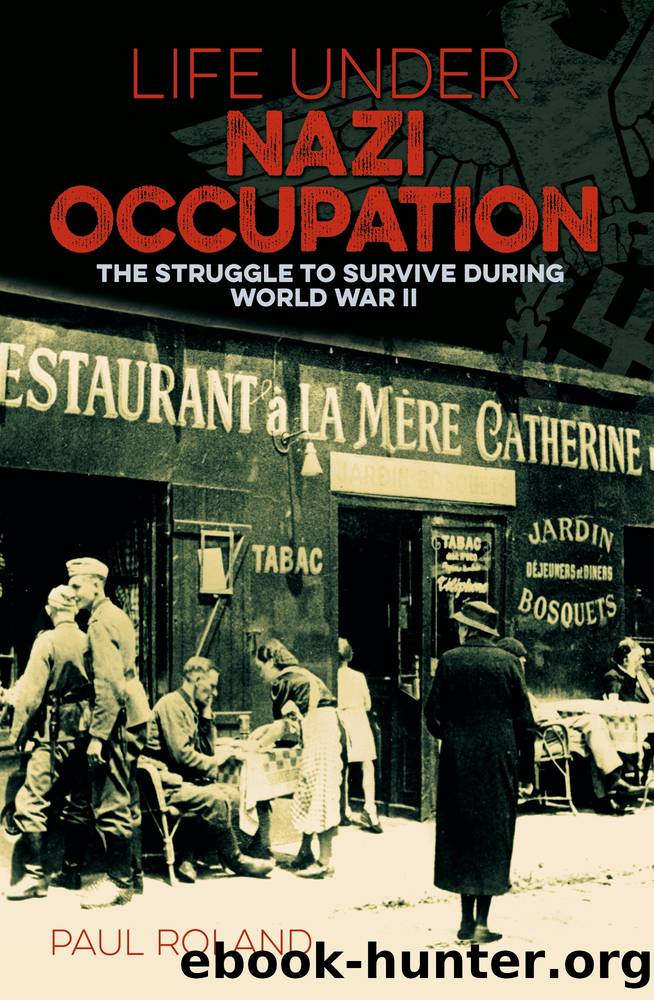Life Under Nazi Occupation by Paul Roland

Author:Paul Roland [Roland, Paul]
Language: eng
Format: epub
Tags: History
ISBN: 9781839404726
Publisher: Arcturus Digital Limited
Published: 2019-12-13T11:40:58+00:00
Rationing
In addition to the lack of electricity, heating, gas and hot water in the early months of the occupation, food rationing reinforced the siege mentality, so that everyone was constantly reminded that they were prisoners in their own country. While the Germans lived on the fat of the land, requisitioning the best accommodation, food and wine for themselves, the general population were forced to live on 1,200 calories a day, roughly half of the required amount for a healthy diet. Shop owners and farmers seen as being too generous were frequently punished by being closed down for a week or two or, in rare cases, permanently. The Germans justified such measures by declaring that the French also had to feed the occupiers and a share of the country’s produce (a third in most cases) was needed to be shipped to Germany, so allowing the population more than their allotted share was effectively stealing from the Reich. Hoping to incite anti-British feeling, they attempted to blame the shortages on the British blockade, but few of the French were taken in by this.
Even basic foodstuffs became a luxury, with coffee being substituted by chicory, which not only tasted bitter but also acted as a laxative if not drunk in moderation. Milk and eggs were often replaced with the powdered variety, while swede, which was in plentiful supply, replaced almost every other vegetable. Also rationed were butter and cheese. For the food-loving French, this made a demoralizing situation intolerable. Oddly enough, two commodities widely and freely available were wine and tobacco, which young adolescents were allowed in compensation for the lack of chocolate and other childhood treats.
A shortage of sugar and salt reduced most meals to a bland, tasteless mush and people were driven to try cooking things they would never have eaten otherwise. Beet, kale, rhubarb and turnips became staple ingredients in lieu of other vegetables, but these had to be eaten in moderation too when it became known that their leaves contained oxalic acid, which is toxic to humans and can cause severe gastroenteritis.
Even fresh fruit, fish and vegetables joined the list of essential produce available only with the requisite ration coupons. Those who owned poultry, pigs and livestock fared better than most, while their less affluent neighbours bred rabbits for the table.
Fears grew for children’s health and vitamin biscuits were introduced to compensate for the lack of adequate nutrition. According to French historian Henry Rousso, the incidence of heart disease was significantly reduced in the middle-aged, who benefitted from the reduction of fat in their diet, while the infant mortality rate rose and malnourishment became common among the young and the elderly. The bitter winters of the war years brought further misery to those for whom shortages of coal and gas and erratic electricity supplies meant little or no hot water and heating. Children frequently sat in classrooms in their coats or skipped school altogether.
Clothes and fabrics were also in short supply, so enterprising and resourceful mothers converted curtains and
Download
This site does not store any files on its server. We only index and link to content provided by other sites. Please contact the content providers to delete copyright contents if any and email us, we'll remove relevant links or contents immediately.
| Africa | Americas |
| Arctic & Antarctica | Asia |
| Australia & Oceania | Europe |
| Middle East | Russia |
| United States | World |
| Ancient Civilizations | Military |
| Historical Study & Educational Resources |
The Radium Girls by Kate Moore(10907)
The Templars by Dan Jones(4188)
100 Deadly Skills by Clint Emerson(4076)
Rise and Kill First by Ronen Bergman(4012)
The Doomsday Machine by Daniel Ellsberg(3730)
The Rape of Nanking by Iris Chang(3516)
Killing England by Bill O'Reilly(3455)
Hitler in Los Angeles by Steven J. Ross(3435)
Stalin by Stephen Kotkin(3084)
12 Strong by Doug Stanton(3057)
Hitler's Monsters by Eric Kurlander(2731)
Darkest Hour by Anthony McCarten(2645)
Blood and Sand by Alex Von Tunzelmann(2608)
The Art of War Visualized by Jessica Hagy(2412)
Hitler's Flying Saucers: A Guide to German Flying Discs of the Second World War by Stevens Henry(2293)
The Code Book by Simon Singh(2209)
The Second World Wars by Victor Davis Hanson(2134)
Babylon's Ark by Lawrence Anthony(2070)
Tobruk by Peter Fitzsimons(2060)
